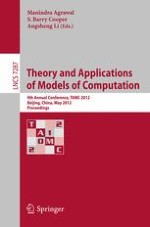This book constitutes the refereed proceedings of the 9th International Conference on Theory and Applications of Models of Computation, TAMC 2012, held in Beijing, China, in May 2012. The conference was combined with the Turing Lectures 2012, dedicated to celebrating Alan Turing’s unique impact on mathematics, computing, computer science, informatics, morphogenesis, philosophy, and the wider scientific world. Eight Turing Lectures were given at the TAMC 2012. The 40 revised full papers presented together with invited talks were carefully reviewed and selected from 86 submissions. The papers address 4 special sessions at TAMC 2012 which were algorithms and information in networks, complexity and cryptography, models of computing and networking, programming and verification.
